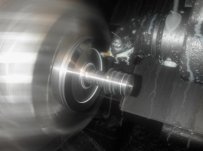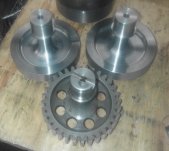I've looked for a long time and never found a good answer. I'm hoping that I'm just not describing the problem in the right terms. Most of the small parts I make have a circular pocket in the top or bottom (or both). pockets range in diameter from 25mm to 32mm and depths from 0.5 to 2mm. The floors need to be smooth and flat. A radius in the wall/floor edge is not a problem at all.
Historically, I've just turned blanks on the lathe and milled the pockets. More recently, I bought a new lathe with live tooling and Y-axis which allows me to mill the pockets, but it seems like there must be a way to turn them.
I've tried using a boring bar for V inserts with the tip pointed forward "SVMBR" (drags on the walls), standard boring bars (rubs on the surface), small solid carbide bars (poor finish on the floor), etc. I've seen face-grooving tools used to make wide grooves, but never tried one and the demos never show them machining to the center. I've seen some single-insert drills that look like they might work, but I don't know how flat of a floor they would make.
Parts are Aluminum, 17-4PH in the H1000 condition, and plastic. Pics attached are an example and drawing.



